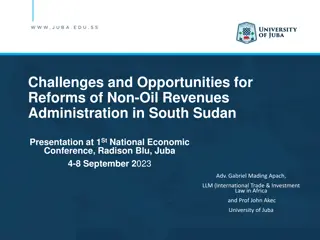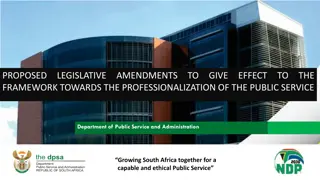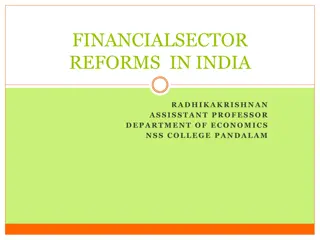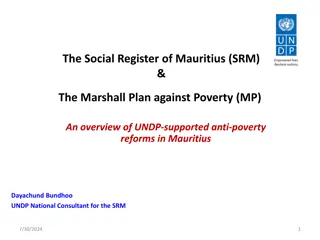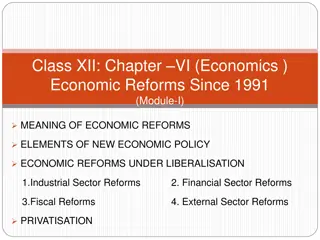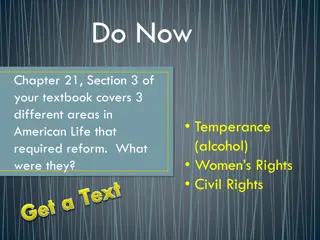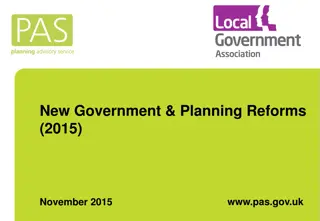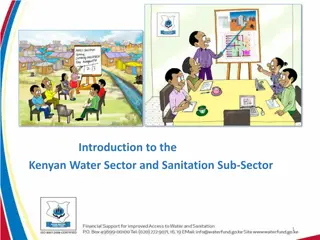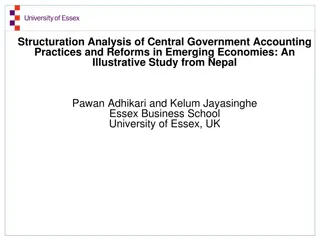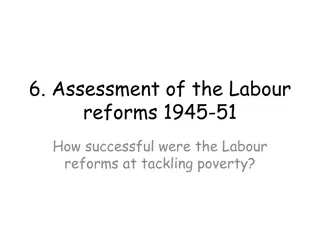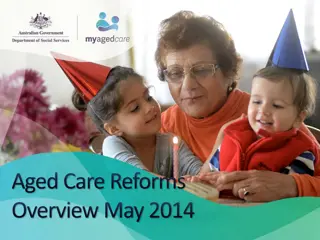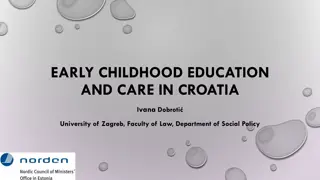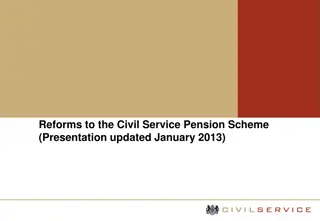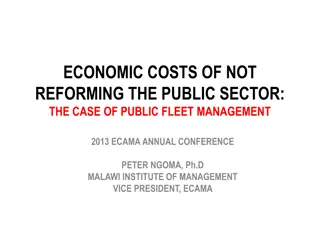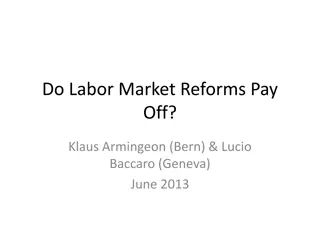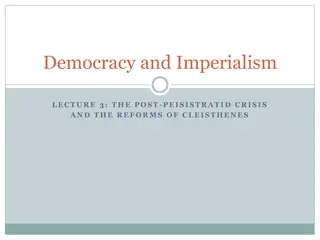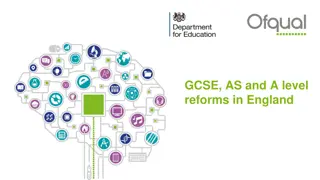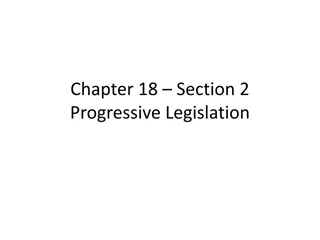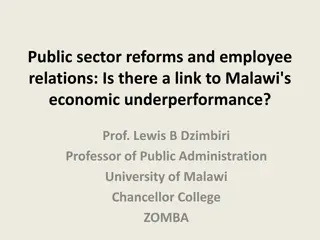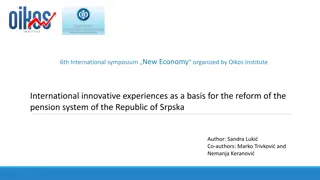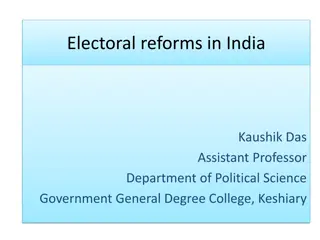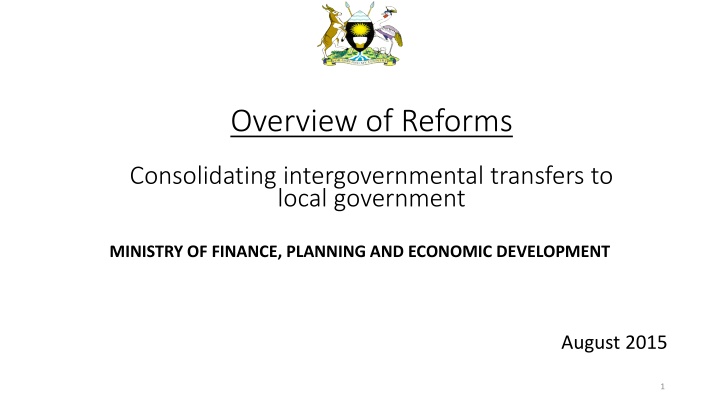
Overview of Reforms Consolidating Intergovernmental Transfers to Local Government
The Ministry of Finance, Planning, and Economic Development in August 2015 presented an overview of reforms aimed at consolidating intergovernmental transfers to local governments. The reforms focused on addressing key issues such as the rise in conditional grants, reduced local government autonomy, disparities in service delivery levels, and more. The presentation outlined the context, planned activities, objectives of the reforms, structure of intergovernmental grants, and the framework from 2016/17 onwards. Additionally, it discussed the introduction of new allocation formulae and shifting the focus of accountability.
Download Presentation

Please find below an Image/Link to download the presentation.
The content on the website is provided AS IS for your information and personal use only. It may not be sold, licensed, or shared on other websites without obtaining consent from the author. If you encounter any issues during the download, it is possible that the publisher has removed the file from their server.
You are allowed to download the files provided on this website for personal or commercial use, subject to the condition that they are used lawfully. All files are the property of their respective owners.
The content on the website is provided AS IS for your information and personal use only. It may not be sold, licensed, or shared on other websites without obtaining consent from the author.
E N D
Presentation Transcript
Overview of Reforms Consolidating intergovernmental transfers to local government MINISTRY OF FINANCE, PLANNING AND ECONOMIC DEVELOPMENT August 2015 1
Structure of the presentation Context for reforms Planned activities in 2015 Objectives of the reforms Structure of intergovernmental grants Framework from 2016/17 and additional features Introducing new allocation formulae Shifting the focus of accountability 2
Context: Key issues Since 1997/98, there has been Which, altogether contributed towards A rise in the number and reliance on conditional grants. Reduced LG autonomy over spending decisions. A real terms decline in the value of non-wage and development conditional grants. Disparities in service delivery levels. Stagnation in the quality of service delivery. Creation of new districts without reviewing LG structures. 4
Context: Discretion and Fragmentation 100% 1997/8 1997/8 90% 10 80% conditional grants 45 Districts 70% 60% 50% 40% 30% 2014/15 2014/15 20% 46 10% 133 districts & municipalities conditional grants 0% Uganda Tanzania Kenya South Africa Unconditional Conditional 5
Context: Funding and Service Delivery Quality Numeracy and Literacy levels Funding Real primary per pupil spending Quantity Expansion in Primary Enrolment 90,000 9 60% 8 80,000 50% 7 70,000 6 40% 60,000 5 50,000 30% 4 40,000 3 20% 30,000 2 20,000 10% 1 10,000 - 0% - 1996 1998 2000 2002 2004 2006 2008 2010 2012 2003 2004 2005 2006 2007 2008 2009 2010 2011 2012 2013 1997/98 1999/00 2001/02 2003/04 2005/06 2007/08 2009/10 2011/12 Primary Salaries Primary Capitation Primary Development Literacy at P6 Numeracy at p6 Primary Enrolment (Million) 6
North East West Central Context: Disparities in Funding and Outcomes Variations in numeracy (P3) across LGs Variations in total per capita transfers across LGs From Shs 34,661 (Wakiso) to 151,932 (Bukwo District) and 260,136 (Soroti MC) From 29% in Amuria District to 99% in Kalangala District 7
Four Phases Planned The first two stages have begun The next phases are starting now 1. Interim Consolidation of Local Government Transfers Collapsing the number of Sector Conditional Grants to 13 in 2015/16 Interim Grant Conditions for Sectoral Transfers prepared 3. Reforming frameworks for accountability and strengthening incentives Strengthening mechanisms for transparent and accountable grant management Introducing performance conditionality to lever institutional and service delivery improvements from 17/18 onwards 2. Reform to Transfers for 2016/17 Consolidating and redesigning discretionary transfers Revising the allocation formulae and principles for grants to LGs Redesign of sector transfers and establishing budgeting requirements 4. Fiscal Decentralisation Architecture & Share of Transfers (LGFC/ FINMAP) Reviewing LG mandates and estimating the cost of adequately financing those mandates relative to the overall budget. Reviewing the overall legal and policy framework for local government revenues and expenditures and recommending changes, taking 9
Reform Objectives Overall objectives to guide the process of reforming transfers: To increase discretion to enable LGs deliver services in line with local needs whilst ensuring that national policies are implemented; To allow new national policies to be funded via the transfer system, at the same time avoiding future fragmentation of transfers and reduction in discretion; To shift the focus away fragmented input-based conditions towards accountability for allocation decisions, expenditures and results; To use the transfer system to provide incentives to improve institutional and service delivery performance; and To restore adequacy and equity in allocation of funds for infrastructure and service delivery. 10
Proposed structure for conditional grants Recurrent Transfer System Sector Development Transfer System Wage Non Wage - Health Cond. - Development Wage Non Wage - Education Cond. - Development Wage Non Wage - Agriculture Cond. - Development Wage Non Wage - Water & Environment Cond. - Development Wage Non Wage - Works Conditional. - Development Wage Non Wage - Community Development Cond. - Development (none) Non Wage - Support Services Cond. - Development Wage Non Wage - District Uncond./Discr. - Development Wage Non Wage - Urban Uncond./Discr. - Development 11
Proposed framework from 2016/17 Six service delivery sectors + support services + discretionary Recurrent transfer system: 36 conditional grants consolidated into 11 grants Maximum of 1 wage and 1 non-wage conditional grant per sector, with earmarking up to the Vote Function Support services incorporate cross-cutting and ad hoc allocations Unconditional grants absorb PSM wage and non-wage grants Development transfer system Maximum of 1 development grant earmarked per sector 1 rural and 1 urban discretionary development equalization grant, replaces equalization grants and harmonizes PRDP, LRDP, USMID, LGMSD Transitional services for temporary allocations up to 5% of sector development grant 1 set of rules and processes for managing all development grants 12
Discretionary Development Equalisation Grant Currently a district or municipality may get three or more discretionary grants it can use for development e.g. USMID, LGMSD, PRDP, Equalisation Grant From 2016/16 an LG will only get only one discretionary development equalisation grant, from one window The grants would be financed from a merger of the PRDP allocation to sectors and USMID, LGMSD; the LRDP; and the local development grant (LGMSD) This would be the vehicle for financing all regional programmes in future. The grants will have a unified formula The global allocation to PRDP and LRDP districts would not be reduced i.e. overall additionality of the PRDP and LRDP would be maintained. West Central East North 13
Illustration for non-wage education grants 2014/15 2015/16 2016/17 One non-wage conditional sector grant, earmarked by grant One non-wage conditional sector grant, at most earmarked to VF Separate non-wage conditional grants 321411 - Primary Education 321419 - Secondary Schools 321432 - Health Training Institutions 321455 - Community Polytechnics 321457 - Technical & Farm Schools 321461 - Technical Institutes 321462 - Primary Teachers' Colleges 321447 - School Inspection Grant 070000-321466 non-wage cond. grant o/w Primary Education o/w Secondary Schools o/w Health Training Institutions o/w Community Polytechnics o/w Technical & Farm Schools o/w Technical Institutes o/w Primary Teachers' Colleges o/w School Inspection Grant Either: 070000-321466 non-wage cond. grant Or, at most: 070000-321466 non-wage cond. grant o/w 0781 Pre-Primary and Primary o/w 0782 Secondary Education o/w 0783 Skills Development o/w 0784 Inspection and Monitoring Transition from individual grants to new framework, illustrated with Education sector 14
Additional features Flexibility to reallocate: Not between sector service delivery grants. Up to 10% between vote functions within a sector service delivery grant. From recurrent to development to promote equalisation New policies will be funded within this framework: Temporary, time-bound earmarking to ensure the new policy is financed; After the time period is over, the allocation becomes part of the sector grant. Performance conditions to improve service delivery results-based financing of service delivery units; or performance-based funding to encourage adherence to LG processes. Straight through processing implemented consistently across sectors 15
New allocation formula Consolidation of grants requires new formulae. New formulae are underpinned by common principles: Formula should be closely linked to the purpose of the grant Formula should be simple, equitable and not undermine incentives to promote service delivery A common approach will be used for all formulae: One formula for all grants within a sector, with min/max allocations for wage, non-wage and development Two formulae for urban/district discretionary (recurrent, development) Data and formulae should be easy for LGs to understand and access 16
Phasing in new formulae Formulae will be phased in gradually to minimize the number of LGs that get less than they do in 2015/16 ( hold harmless approach). The pace of introduction will be determined as follows: Estimate of fiscal space to increase transfers Calculate the share of each LG under the new formula Gradually increase allocations for districts below target level Phase in changes more rapidly for development grants than for recurrent These changes are reflected in the MTEF. 17
Focus on Accountability Reliable, comparative and readily interpretable information on allocations, expenditures and results for local government needs available to local and central government actors, civil society and the public. Robust processes of monitoring, provision of feedback and follow up need to be in place and compliance enforced. 18
Thank You Any Questions? 19

